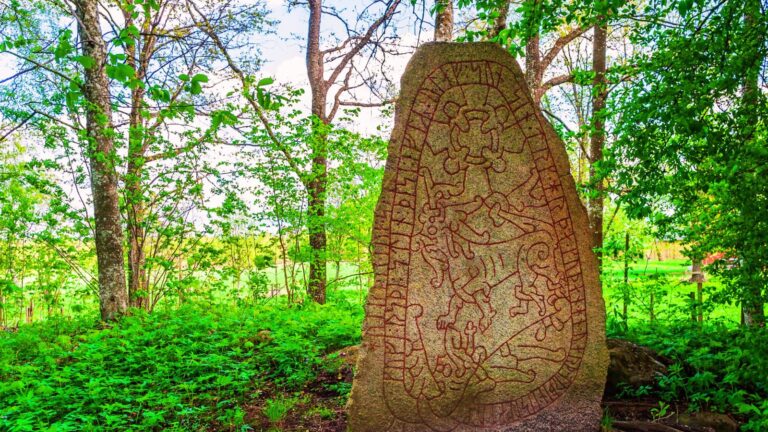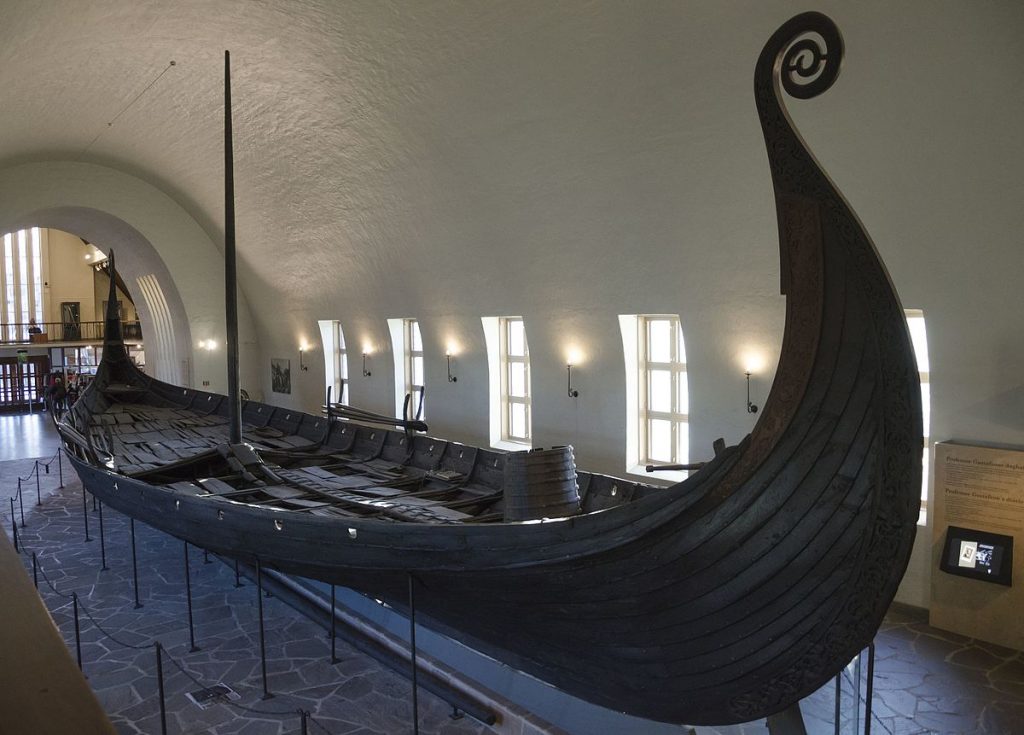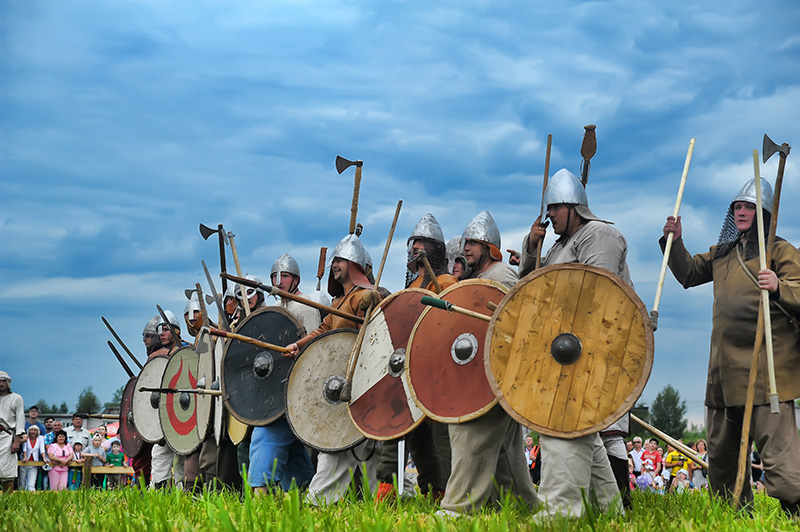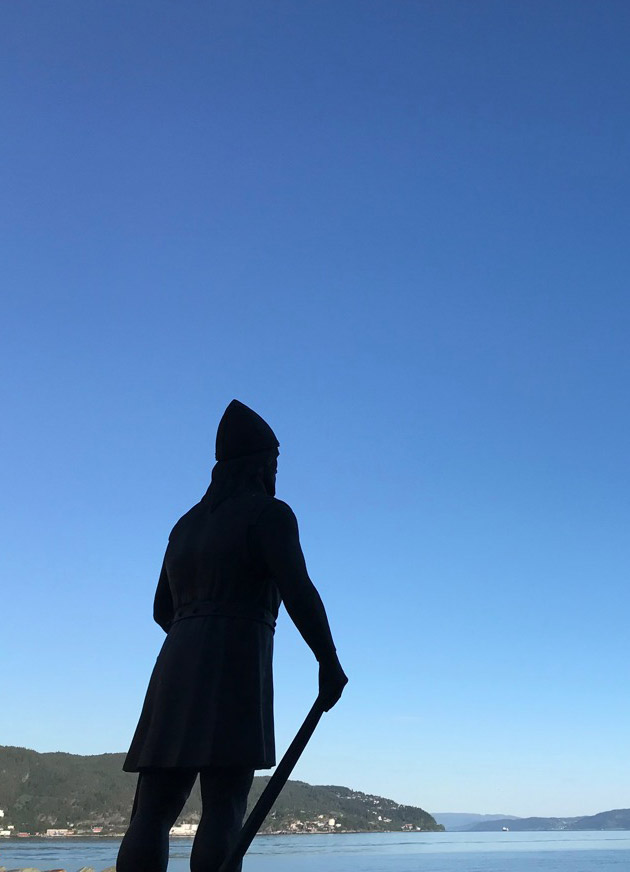Explore the key events of the Viking Age, from the first raids in the late 700s to the decline of Norse power, including major battles, exploration, and the lasting impact of Viking settlements.
Ah, the Vikings! The image of these seafaring warriors has been shaped over time—from fierce raiders and conquerors to explorers, traders, and even settlers who shaped entire regions of Europe and beyond.

Since moving to Norway, I've had the chance to dive deeper into Viking history, discovering how their legacy still resonates today in Scandinavian culture, language, and traditions. It's a fascinating journey that reveals so much more than just battles and longships!
The Viking era is the period following the Germanic Iron Age. From around the year 793 to 1066, Norsemen used rivers and oceans to explore Europe for trading, raiding and conquest.
Of course, history from so long ago is far from exact. Much of what we know about the era is based on Icelandic sagas, stories that were written hundreds of years after the events took place. If they ever took place at all. This is one of the biggest criticism of Viking stories.
What historical records there are tend to have been left by the people that the Norsemen conquered. So while those accounts will likely paint a one-sided picture, they do at least help us begin to pull a timeline of Viking history together.
Bear in mind when reading these dates and facts that many historians disagree on the details! In some cases the dates aren’t clear, in others there’s some doubt whether the events even happened at all.
The Early Days
Late-700s: Viking Raids Begin. By the late 8th century, Norse society had evolved into a formidable seafaring culture of raiders, traders, and explorers. Norsemen targeted vulnerable Christian monasteries and settlements, particularly on small, isolated islands. These early raids were swift and brutal, capitalising on the lack of protection in these remote areas, and they signalled the start of widespread Viking incursions throughout the British Isles and beyond.
793: Major attack on Lindisfarne. One of the most famous early raids was in 793 at Lindisfarne, north east England. Such was the ferocity of the attack, it sent shockwaves not just throughout the British Isles, but throughout Europe. It was described by Anglo-Saxon writers as such: “Heathen men came and miserably destroyed God’s church on Lindisfarne, with plunder and slaughter,” according to English Heritage.
830: The Oseberg ship is buried. Arguably the finest artefact to have survived the Viking age, the Oseberg ship discovered near Tønsberg was buried around this time. The skeletons of two women were found with the ship. The ship is today on display in Oslo, while a reconstruction bobs in the harbour of Tønsberg.

830s: Viking Settlements in Ireland. Vikings began to establish settlements in Ireland, turning it into a major Viking hub and a launchpad for future raids in Britain and Europe.
840: Norse settlers found Dublin. Or rather, they seized the ecclesiastical settlement and began to build a camps of their own. Dublin would, of course, go on to become the capital of the Republic of Ireland.
Far and Wide
844: Muslims repel a Viking raid in Spain. Viking raiders ventured far beyond their traditional northern territories, sailing into the Iberian Peninsula. sailed up the Guadalquivir River and sacked the wealthy city of Seville within the Umayyad Emirate of Córdoba. However, Emir Abd al-Rahman II swiftly organised a counterattack, defeating the Vikings near Tablada. Many Viking ships were destroyed, and the raiders were forced to retreat, marking the end of their raids in the region.
Read more: Fun Facts About The Vikings
860: Discovery of Iceland. Iceland, uninhabited by humans, was first sighted by Norse sailors around 860. Naddodd, blown off course, named it Snæland (Land of Snow). Garðar Svavarsson later confirmed it was an island, naming it Garðarshólmi. Flóki Vilgerðarson, who brought ravens to help navigate, named it Ísland (Iceland) after a harsh winter.
866: Vikings establish a Kingdom in York. Danish Vikings take York in the north of England, and establish a Kingdom. The Northumbrian kings Aelle and Osbert were not captured, however. You can learn more about York's perspective on the era's history at the Jorvik Viking Centre.
874: Settlement of Iceland. Ingólfr Arnarson became Iceland’s first permanent settler. His settlement marked the start of the Landnám period (Settlement Period), which lasted until 930, as Norse settlers established farms and a unique society.
Control and Establishment
872: Harald I gains control of Norway. According to medieval Icelandic historians, Harald Fairhair (Harald hårfagre) became the first King of Norway and would rule to 930. He was regarded to have unified Norway after the the Battle of Hafrsfjord. The famous swords sculpture in Stavanger (Sverd i fjell) commemorates this moment.
878-890: Danelaw begins. The Danelaw pact was formalized through the Treaty of Alfred and Guthrum after Alfred's victory at the Battle of Edington in 878. The treaty established a division of England, with the Danelaw covering northeastern regions, including East Anglia, while Alfred controlled the south and west. Norse settlers influenced the culture and law in their territories. The treaty also required Guthrum to convert to Christianity, further solidifying peace between the two sides.
Vikings in Southern Europe
900s: Trade with the Byzantine Empire: Viking traders, known as the Varangians, established important trade routes along the rivers of Eastern Europe, eventually reaching Constantinople (modern-day Istanbul). The Varangian Guard, composed of Viking warriors, became an elite unit of the Byzantine Emperor’s forces.

911: Rollo founds Normandy in France. Viking chief Rollo is granted land by the Franks after he besieged Paris. The descendants of Rollo and his followers adopted the local languages and became the Normans.
Battles in Britain
910: Battle of Tettenhall / Wednesfield. A major turning point in the fight between the English kingdoms and the Danish Vikings. Allied forces from Mercia and Wessex, led by King Edward the Elder and his sister, Æthelflæd, Lady of Mercia, decisively defeated the Northumbrian Vikings. The Viking forces had been raiding deep into Mercian and Wessex territories, but this battle saw the destruction of a significant Viking army.
918: Battle of Corbridge. Taking place on the banks of the Tyne, the Battle of Corbridge was fought between Norse-Gael leader Ragnall ua Ímair and his allies against Constantine II of Alba and Ealdred I of Bamburgh. According to the Annals of Ulster, the Norse-Gael army was split into four columns. The Scottish forces defeated the first three columns but were ambushed by the fourth, leading to fierce fighting and an indecisive outcome. Despite this, the Vikings did not advance further into Scotland, and Ragnall capitalized on Northumbria's weakness, seizing York in 919 and declaring himself King of southern Northumbria.
Even Farther, Even Wider
930: Icelandic Parliament. Norse settlers in Iceland formed the Althing, one of the world’s oldest parliaments. This firmed up the settlement of Iceland and spurred further Viking exploration, leading to the discovery of Greenland and North America.
941: Rus Vikings attack Constantinople. The Rus and their allies took advantage of the Byzantine fleet and army being thinly spread. The Imperial capital essentially stood defenceless. The Rus' were said to have violently killed their victims. It was one of many wars between the two sides.
981: Erik the Red discovers Greenland. Expelled from Norway and later Iceland, Erik the Red settled in Greenland with 25 ships, people, and goods. Within around 20 years, more than 3,000 Vikings were said to be living on Greenland as farmers, establishing two main settlements, the Eastern Settlement and the Western Settlement.

986: Viking ships sight Newfoundland. L'Anse aux Meadows National Historic Site is the only authenticated Norse site in North America. Leif Erikson is the man credited with discovering the region, but according to stories it was Bjarni Herjolfsson who first discovered the land, having been blown off course from a journey to Greenland. About 10-15 years later, Erikson would go on to lead an expedition to the New World.
Growing Influence of Christianity
995: Norway's Viking King builds a Christian church. The founder of Trondheim, Olav Tryggvasson built the first Christian church in Norway. He had spent time on the Scilly Isles, where a seer is said to have foreseen a battle in which Tryggvason would suffer great wounds and then convert. Shortly after the meeting he survived a vicious attack, and duly converted. He returned to Norway to take the throne, and so began Norway's slow conversion.
1000: Christianity arrives in Iceland and Greenland. Although the faith had already begun to spread, it really took hold when Norway's King Olav began to convert chieftains. He also imposed trade restrictions on those that refused.
The Last Days
1015: The North American settlement is abandoned. The Viking settlement in Vinland (modern-day Newfoundland, Canada) was abandoned, likely due to hostile encounters with indigenous peoples, limited supplies, and the challenges posed by the long, hazardous journey required to trade with Scandinavia.
1030: The Battle of Stiklestad. Norway's Christian King Olav Haraldsson was defeated in the Battle of Stiklestad. Though defeated by pagan forces, Olav’s martyrdom spurred the spread of Christianity in Norway. Churches and shrines dedicated to him were erected across Scandinavia and Europe, solidifying his legacy as Norway’s patron saint. However, some historians question the circumstances of his death, suggesting Olav may have been betrayed by his own men.
1066: Battles in England and the end of the Viking Age. The year 1066 is often considered the official end of the Viking Age by scholars. In September, King Harold Godwinson of England defeated the Norwegian king Harald Hardrada at the Battle of Stamford Bridge, ending Viking ambitions in England. Hardrada’s death marked the last major Viking attempt to invade the British Isles. However, just three weeks later, Harold Godwinson himself was defeated by William, Duke of Normandy, at the Battle of Hastings. Ironically, William was a descendant of Viking settlers in France, showing the lasting influence of Viking heritage even as their era of raiding and conquest came to a close.
12th Century: Decline of Greenland Colonies. The Norse settlements in Greenland began to decline during this century due to climate change (the Little Ice Age) and isolation, which is an interesting post-Viking expansion detail.
13th Century: Iceland submits to Norway. Iceland’s independence came to an end in 1262 with the signing of the Old Covenant (Gamli sáttmáli), a treaty that formalised the island’s submission to the rule of the Norwegian King Hákon IV. This submission was driven by internal strife during which Iceland was torn apart by powerful local chieftains vying for control. In exchange for accepting the authority of the Norwegian crown, Icelanders were promised trade benefits and legal protection.


Very interesting and little about norwegian history is known in the rest of europe.
So what is taught in Norwegian schools about the history of the country? How much about the vikings is taught?
Hello,
When I Green up, a long time ago( in the sixties) we learned quite a lot about the history of Norway. And of the old vikings. It got me very interrested in the stories from Island, and the stories in the old books in the villages where my ancestors come from.
But remember that Norway was under Danish and later Swedish rule for many hundred years, not alloud to write, nor practice the Norwegian culture. A bit like the Scots. And by 1906, when they got their independance, were among the poorest countries in Europe.
But by 1950 had raise the Main Society to well off( before they discovered the oil)
In 1880 they took back the language and called it New Norwegian ( Nynorsk) And now that language is practiced beside the Danish version ( Bokmål) called the booklanguage, since all books before 1880 was in Danish.
But we were taught in school about Leiv Ericson who discovered Amerika. And about Harald Hårfagre who gathered Norway to one country ( it was a lot of small Kingdoms around in the areas.
Where my ancestors come from ( Vangsnes, Vik in Sogn ) they had a king Bale around year 700 together with a king Ring further east.
Always fights and rivalry.
Though we did not learn that in school😂
Thank you for the information, I to am of Viking descent and would love to know more of my own history.
I used this for my project on northern Europe.
This help me for my Vinking Lindisfarne Topic storyboard.
I’m 62. My mom had stories told my her mom and so on. Anyway, They were Swedish and Norwegian (actually my Great Grandfather was Norwegian) and we were told women had much more to do with everything but whatever.
I do however wonder why these learned people fail to check in w/Native Americans? I had a friend who from the first time she saw me determined we’d be friends simply because her Grandfather had told her the only non-Indian (her term) to be trusted was a Norsman. From the first time she saw me she pegged me as such. So why not check with some Atlantic Tribes? Just a thought because if Vikings stayed and accepted the same ways it would explain why it’s thought they simply disappeared.
To bad the Norse didn’t settle the US instead of the British! Maybe we would have more native Americans in charge!
Geeze, seriously?
I agree with Carolyn. And probably they would have never be sent to those “reservation camps”… In their own country and lands…
On the other hand, we have to realize that the Brittish, Norwegian, Spanish, etc. from those years, were not as those with the education and culture that we have got nowadays…
Maybe I am wrong…:)
This helped with my Individual and Societies project, Cheers 🥳
Despite Viking short lived history. What have they contributed to other less advanced and advanced societies besides making their themselves known as voyagers, pirates, partial land grab and economically motivated with plunder.
They had potential but they lack political, administrative governance, advanced institutions and infrastructure to hold their dominance for centuries to come to bear fruit of it all.
Vikings had a interesting life they have lived. However, the Greek, Egyptians, Romans/Spain, Islam/Ottomans, China, Korea, Japan had a vest historical and long rich history that can be accounted for.
You can thank the vikings for several groups of people still being in existence today. The Vikings well could have arrived to find that all the men were dead, the villages burnt, and riches were gone, so they simply rescued the women and children!
My Swedish mother always told my Irish stepfather that he was more Swedish than Irish and he would always laugh at her, but after your information I can understand why she felt the way she did.
I visited the Viking ship in the Oslo museum several years ago and it is most impressive to view.
There is statue of lief Ericson in Ballard neighborhood in seattle
That area north of Seattle has quite a bit of Scandinavian influence and settlement. Good seafood, great bread ! Also down the coast, Oregon and even into coastal/mid California. But I wouldn’t call it Viking by any means.
In reply to your points about the Vikings discovering Newfoundland, its important to remember no European ever discovered the Americas. The Americas are the rightful homelands of numerous diverse communities of human beings both before and after this so-called discovery.
Since my ancestry is 100% Norwegian, I am quite interested in Viking history, and have assembled a large collection of historical material: books, videos, written discussions, paintings, etc. My grandfather “Sam” Guddall immigrated to Iowa, USA in the 1880’s, by sailing ship with his family when he was 8 years old. Otherwise, all of my great-grandparents were born in Norway. A strong and proud ancestry! For many years I have worn a silver mojindar (Hammer of Thor) amulet on a small silver neck chain, not for any religious reasons, but to honor my heritage.
I looked this up following a trivia question as to names of the week. I thought that the Norse influence must have been great for the world to accept the names given. I wanted to know more
I have read a theory that the settlement in Greenland was abandoned because of the introduction of elephant ivory in Europe. The value of walrus ivory crashed due to it’s inferior quality. The trade of ivory probably being a significant source of trade providing important supplies from Europe.
It is too bad that the Vikings left the settlement in northern Newfoundland after a couple of years because then they would be honoured instead of Christopher Columbus and then maybe the whole of North America would have a Scandinavian background and there would be less friction between its people.
Thanks for the information! Im going to use this for my end of year project!
Thank you!
How about the RUS Russia
We should keep in mind that the word Viking simply means “Pirate”, and that it can point to several different cultures of those days, including Jutes, Danish, but also Frisians. A better word would be “Scandinavians” to point towards a specific group of people.
My mother was from East Yorkshire .Her sister married a Norwegian and I lived for a while with her in Bergen . (I am a fluent Norwegian speaker.) I recently discovered that there is something called Dupuytrens Contracture which affects the ligaments of fingers and toes. Apparently brought into the U.K. by the Vikings .My Mother and her sister both had this and my daughter! I was able to tell Mum’s brothers family who live in Australia about this .They told me that my Uncle also had it!. I recently had my DNA done . Sure enough we have DNA from Norway!
Interesting history of the Vikings. My mother and father are from Norway, so I am a first generation Norwegian American. Just for fun I asked my mother one time why they call us square heads. She said because we are honest. I told her it is because our heads are square. Anyway, keep the stories about Norway coming.